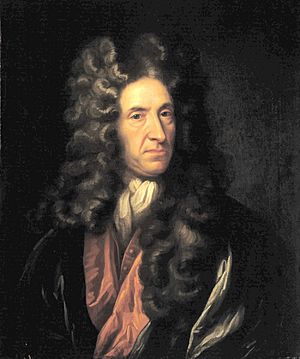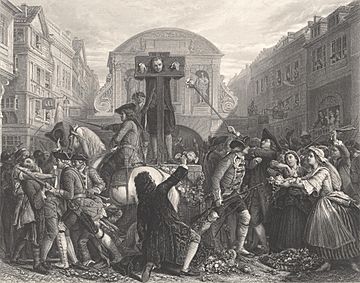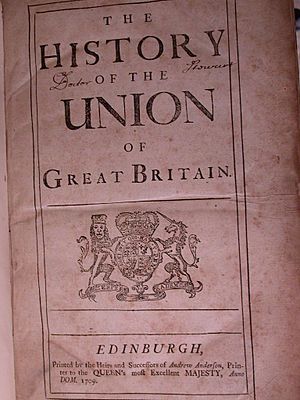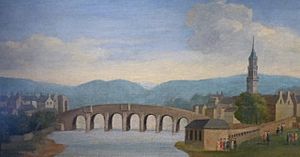Daniel Defoe facts for kids
Quick facts for kids
Daniel Defoe
|
|
|---|---|
 |
|
| Born | Daniel Foe c. 1660 London, England |
| Died | 24 April 1731 (aged 70) London, England |
| Resting place | Bunhill Fields |
| Occupation | Writer, journalist, merchant |
| Genre | Adventure |
| Spouse | Mary Tuffley |
Daniel Defoe (born Daniel Foe; around 1660 – 24 April 1731) was a famous English writer, businessman, and journalist. He is best known for his exciting novel Robinson Crusoe, published in 1719. This book is so popular that it's said to be translated into more languages than any other book, except for the Bible!
Many people see Defoe as one of the first writers of the modern English novel. He helped make this type of story popular in Britain. Defoe wrote many articles about politics and sometimes got into trouble with the government. Important thinkers and leaders often listened to his new ideas.
Defoe was a very busy writer. He created over 300 different works, including books, short articles, and journals. He wrote about many different topics like politics, crime, religion, and even mysterious things. He also helped start a new way of writing about business and money.
Contents
Daniel Defoe's Early Life and Education
Growing Up in London
Daniel Foe, his original name, was probably born in Fore Street in London. He later added "De" to his name, making it sound more fancy. We're not completely sure when or where he was born, but most people think it was around 1660.
His father, James Foe, was a successful tallow chandler, which means he made and sold candles. When Daniel was a child, he lived through some amazing and scary events in English history. In 1665, a terrible sickness called the Great Plague of London killed 70,000 people. The very next year, the Great Fire of London destroyed much of the city. Luckily, only Defoe's house and two others in his area were left standing. When he was about seven, a Dutch fleet attacked a town called Chatham near the River Thames. His mother, Alice, passed away when he was about ten years old.
School Days
Defoe went to a boarding school in Dorking, Surrey. His parents were Presbyterian Dissenters, which meant they chose to worship outside the official Church of England. Around age 14, he went to a special school called a dissenting academy in Newington Green. These schools were important because they allowed people who weren't part of the Church of England to get an education. During this time, the English government often treated people who worshipped differently quite harshly.
Daniel Defoe's Business and Public Life
Starting a Business
Defoe began his career as a merchant, buying and selling different goods like socks, wool, and wine. He had big dreams and even bought a country home and a ship! He also owned civets to make perfume. However, he often had money troubles.
On January 1, 1684, Defoe married Mary Tuffley. Her father was a London merchant, and Mary brought a large sum of money, £3,700, with her. This was a huge amount back then! Even with this money, his financial problems and political activities made their marriage difficult, but it lasted 47 years, and they had eight children.
Working for the Government
In 1685, Defoe joined a rebellion that didn't go well, but he was pardoned and avoided serious punishment. When Queen Mary and William III became rulers in 1689, Defoe became a close friend and even a secret agent for William. Some of the new government's plans led to disagreements with France, which hurt Defoe's trading business.
In 1692, he faced serious money problems and had to declare that he couldn't pay his debts. He ended up owing a very large amount of money. He passed away with little wealth and was still dealing with legal issues about his finances.
After being released from prison for his debts, he likely traveled around Europe and Scotland. He might have traded wine in places like Cadiz and Lisbon. By 1695, he was back in England, now officially using the name "Defoe." He worked as a "commissioner of the glass duty," collecting taxes on bottles. In 1696, he ran a factory that made tiles and bricks in Tilbury, Essex.
Daniel Defoe's Writing Career
Defoe wrote an amazing number of works, possibly as many as 545! These included funny poems, political and religious articles, and many books.
Writing and Trouble with the Law

Defoe's first important book was An Essay Upon Projects (1697). It suggested ways to improve society and the economy. He also wrote poems and articles defending King William III. His most famous poem, The True-Born Englishman (1701), defended King William against people who disliked him because he wasn't English.
When King William III died in 1702, Queen Anne took over. She was not friendly to Nonconformists like Defoe. Because of his writings and political actions, Defoe was arrested. He was put in a pillory (a device for public punishment) on July 31, 1703. This happened mainly because of an article he wrote called The Shortest Way with the Dissenters. In it, he used strong satire to make fun of both strict Church of England members and Dissenters who pretended to follow the Church of England.
His article was published without his name, but soon everyone knew he wrote it. He was found guilty of writing things that upset the government. He was fined a lot of money, put in the pillory, and sent to Newgate Prison. Legend says that when he was in the pillory, people threw flowers at him instead of rotten things, and even drank to his health, because of a poem he wrote called Hymn to the Pillory. Most historians aren't sure if this is completely true.
After three days in the pillory, Defoe went to prison. A powerful politician named Robert Harley helped him get out. In return, Defoe agreed to work as a secret agent for Harley's political group. Harley also helped Defoe with his money problems.
Soon after leaving prison, Defoe saw the Great Storm of 1703, a terrible storm that hit Britain. It caused huge damage and killed many people. Defoe wrote a book about it called The Storm (1704), which included stories from people who saw it. Many people think this book is one of the first examples of modern journalism.
He also started a newspaper called A Review of the Affairs of France, which came out three times a week until 1713. He used it to support the government's policies.
Helping with the Union of Great Britain
While in prison, Defoe wrote to William Paterson, a Scottish banker who worked closely with Robert Harley. Harley hired Defoe and released him in 1703. Defoe's newspaper, The Review, became the main voice for the English government, promoting the Act of Union 1707. This Act would join England and Scotland into one country, Great Britain.
Defoe began writing articles to convince English people that the Union would be good for them. In September 1706, Harley sent Defoe to Edinburgh, Scotland, as a secret agent. His job was to help make sure the Treaty of Union was accepted. He knew it was a risky job. We know a lot about his work there from his letters.
He reported on violent protests against the Union in Scotland. He wrote that "A Scots rabble is the worst of its kind."
Because Defoe was a Presbyterian who had faced difficulties in England for his beliefs, he was accepted as an advisor by Scottish religious and political groups. He told Harley that he was "privy to all their folly" but "Perfectly unsuspected as with corresponding with anybody in England."
For the Scottish people, he used different arguments, sometimes even the opposite of what he told the English. He tried to convince Scots that they could trust the promises in the Treaty. Some of his articles were written as if they were from Scots, which even tricked some historians later on. He also wrote a huge history of the Union in 1709, which some historians still use as a source.
After the Union
In 1709, Defoe published The History of the Union of Great Britain. This book talked about the events leading up to the 1707 Union, even going back to 1604 when King James I first suggested joining England and Scotland.
Defoe didn't get much reward or recognition from the government for his work on the Union. He later used his experiences in Scotland to write his book Tour thro' the whole Island of Great Britain (1726). In this book, he admitted that the increase in trade and population in Scotland that he had predicted from the Union "was not the case, but rather the contrary."
Defoe described Glasgow as a "Dear Green Place." This phrase is often mistakenly thought to be the Scottish Gaelic meaning for the city's name. The Gaelic word Glas can mean grey or green, and chu means dog or hollow. So, Glaschu probably means "Green Hollow." Glasgow, like much of Scotland, was a place where people were very upset about the Union.
When Defoe visited Glasgow in the mid-1720s, he said that people were unfriendly to his group "because they were English and because of the Union, which they were almost universally exclaimed against."
Later Writings
After 1714, Defoe continued writing, leading up to his most famous novel, Robinson Crusoe, in 1719. He also wrote books that gave advice on how to live, like Religious Courtship (1722) and The Complete English Tradesman (1726). He wrote about mysterious topics too, such as The Political History of the Devil (1726). His books about travel and trade include A General History of Discoveries and Improvements (1727). One of his most important works, besides his novels, is A tour thro' the whole island of Great Britain (1724–1727). This book gave a detailed look at British trade just before the Industrial Revolution.
The Complete English Tradesman
Published in 1726, The Complete English Tradesman was one of Defoe's important works about society and money. In this book, Defoe talked about the role of the tradesman in England. He argued that the British way of trading was much better than others.
Defoe also suggested that trade was the most important part of the British economy. He wrote, "estate's a pond, but trade's a spring," meaning that land might be a steady source of wealth, but trade brings new and growing wealth. Defoe believed that trade was practical and important for society. He argued that most of the British gentry (upper class) were connected to trade in some way, either through their own work, marriage, or family history. Often, younger members of noble families would go into trade, and it was common for noblemen to marry a tradesman's daughter. Overall, Defoe had great respect for tradesmen, as he was one himself.
Defoe not only praised individual British tradesmen but also believed that British trade as a whole was better than other trading systems. He argued that trade was a much better way to create social and economic change than war. Defoe also thought that by expanding the British Empire and its trading influence, Britain could "increase commerce at home." This would create more jobs and lead to more people buying things. He wrote that more buying would lead to more production, which would then raise wages for poorer people, helping them out of poverty.
Daniel Defoe's Famous Novels
Robinson Crusoe
Defoe was in his late fifties when Robinson Crusoe was published. This exciting story is about a man who is shipwrecked on a lonely island for twenty-eight years and his adventures there. Throughout the book, Crusoe struggles with his faith, making promises to God when he's in danger. But after he's saved, he often forgets his promises. Eventually, he finds peace and happiness with his life, away from society, after a true change in his beliefs.
The novel is thought to be partly based on the real story of Alexander Selkirk, a Scottish sailor who was stranded on the Juan Fernández Islands for four years. The island Selkirk lived on was even renamed Robinson Crusoe Island in 1966. Some people also believe Defoe might have been inspired by a book from an Arab writer named Ibn Tufail, which was translated into English in 1708.
Captain Singleton
Defoe's next novel was Captain Singleton (1720), an adventure story. The first part describes a journey across Africa, which was amazing because it talked about places that explorers like David Livingstone would discover much later. The second part of the book is about piracy, a popular topic at the time. The novel is praised for showing the close friendship between the hero and his religious guide, William Walters, who was a Quaker.
Memoirs of a Cavalier
Memoirs of a Cavalier (1720) is a story set during two important wars: the Thirty Years' War in Europe and the English Civil War in England.
A Journal of the Plague Year
A Journal of the Plague Year, published in 1722, can be read as both a novel and a factual account. It tells the story of the Great Plague of London in 1665. The book is signed with the initials "H. F.", suggesting that Defoe's uncle, Henry Foe, was the main source of information. It's a historical account based on a lot of research and written as if someone who saw the events was telling the story, even though Defoe was only about five years old when the plague happened.
Colonel Jack
Colonel Jack (1722) follows an orphaned boy who goes from a life of poverty and crime to becoming successful in the colonies. He has adventures in the military and in his marriages, and he finds religious faith. The story explores his journey to becoming a "gentleman."
Moll Flanders
Also in 1722, Defoe wrote Moll Flanders. This is another story told by the main character, a woman living in 17th-century England. It's about her journey from difficult times to eventually finding success and spiritual peace. The main character, Moll, is a bigamist (married to more than one person at a time) and a thief. She is clever at dealing with men and money, which leads her through many challenges but ultimately to a rewarding life. While Moll sometimes thinks about whether her actions are right or wrong, religion isn't her main concern for most of the story. However, like Robinson Crusoe, she eventually changes her ways. Moll Flanders was an important book because it challenged how people thought about women and their roles in British society in the 1700s.
Common Themes in Defoe's Novels
In Defoe's writings, especially his novels, you can find common themes. Defoe was known for teaching lessons through his stories, often moral ones that came from his religious background. He also often wrote his fictional works as if they were true stories about real people.
Daniel Defoe's Death
Daniel Defoe passed away on April 24, 1731. He was probably hiding from people he owed money to, as he often had money troubles and was sometimes in prison for debts. The cause of his death was listed as "lethargy," but he likely had a stroke. He was buried in Bunhill Fields in London, where a monument was put up in his memory in 1870.
Selected Works by Daniel Defoe
Novels
- The Consolidator, or Memoirs of Sundry Transactions from the World in the Moon (1705)
- Robinson Crusoe (1719) – This famous story was first published in two parts:
- The Life and Strange Surprizing Adventures of Robinson Crusoe, of York, Mariner: Who Lived Eight and Twenty Years [...]
- The Farther Adventures of Robinson Crusoe: Being the Second and Last Part of His Life [...]
- Serious Reflections During the Life and Surprising Adventures of Robinson Crusoe (1720)
- Captain Singleton (1720)
- Memoirs of a Cavalier (1720)
- A Journal of the Plague Year (1722)
- Colonel Jack (1722)
- Moll Flanders (1722)
- Roxana: The Fortunate Mistress (1724)
Nonfiction Books
- An Essay Upon Projects (1697) – This book includes ideas for improving society, like banks, roads, and even a proposal for a women's academy.
- The Storm (1704) – Describes a terrible storm that hit Britain, including stories from people who saw it.
- The Family Instructor (1715)
- Memoirs of the Church of Scotland (1717)
- A tour thro' the whole island of Great Britain, divided into circuits or journies (1724–1727)
- A New Voyage Round the World (1724)
- The Political History of the Devil (1726)
- The Complete English Tradesman (1726)
- A Plan of the English Commerce (1728) – Explains how England's wool industry grew through government policies.
Short Articles and Essays
- The Poor Man's Plea (1698)
- The History of the Kentish Petition (1701)
- The Shortest Way with the Dissenters (1702)
- The Apparition of Mrs. Veal (1706)
- An Appeal to Honour and Justice, Tho' it be of his Worst Enemies, by Daniel Defoe, Being a True Account of His Conduct in Publick Affairs (1715)
- Every-body's Business, Is No-body's Business (1725)
Poems and Verse Essays
- The True-Born Englishman: A Satyr (1701)
- Hymn to the Pillory (1703)
Images for kids
See also
 In Spanish: Daniel Defoe para niños
In Spanish: Daniel Defoe para niños
- Apprentice complex
- Moubray House











